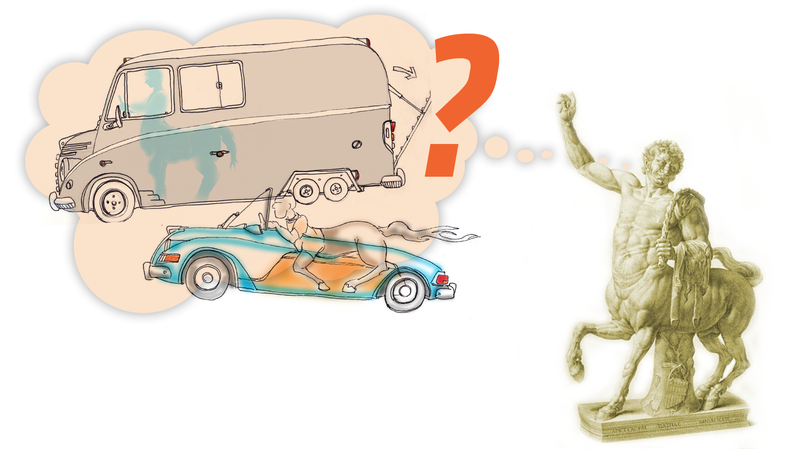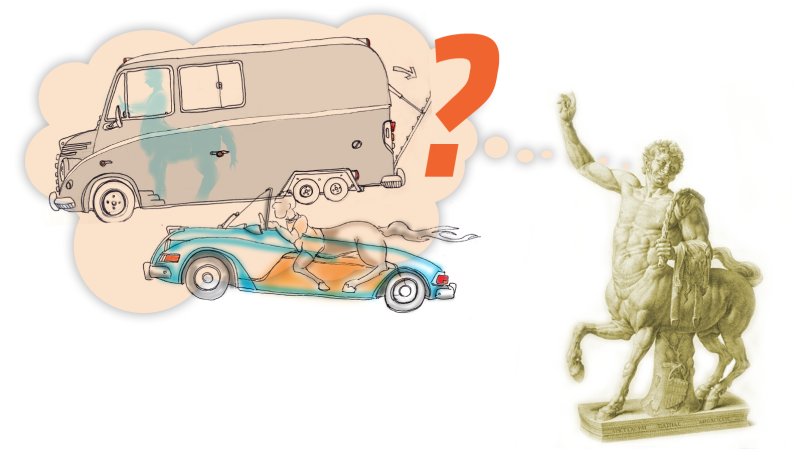
The world is a complicated place, and our lives our rich and complex as well. This means that it’s easy to get caught up in the involved business of living, with work and relationships and processing the outside world’s madness. The result is that far too often we find ourselves without the opportunity to tackle the really big, important questions of life, like speculating what sorts of cars centaurs would drive. I intend to resolve this issue, right now.

In case you’re somehow, bafflingly, unaware of what a centaur is, it’s an (allegedly) mythological creature from ancient Greek mythology that’s half-human and half-horse. The human part comprises the body down to the waist, and is joined to a horse’s body at about the point where a horse’s neck would start.

I am of the opinion, like many others, that the genitals would be in the horse-location, not the human-location, in case you were wondering.
Advertisement
Having essentially an entire horse as a body offers centaurs some unique benefits and challenges when it comes to locomotion. First, they’re far more capable than humans of traveling quickly, and for longer distances, since they have a built-in horse.
This means that for a lot of travel, they may not even require motor vehicles, since they can just gallop wherever they need to go, within certain limits. This doesn’t mean they wouldn’t want cars at all, though, because, remember, they still have the brains of a human, and one of the defining traits of human brains is a deep-seated desire not to bust our asses needlessly.
Galloping five minutes or so to get to a café around the corner is one thing; galloping for two hours to get to a concert in another city is a very different situation, and one that would require a motor vehicle.
Advertisement
Plus, there’s weather and climate considerations: even if you could run at 25 MPH easily to get around, would you really want to do that in the cold and rain? No, hell no. You’re still going to want a car.
The biggest challenge of a centaur-mobile is pretty obvious: they’re huge. And not just in external dimensions: an average horse weighs about 1,100 pounds, and I think we can assume your average centaur is pretty close to this. That means that a four-centaur car will be carrying around about 4,400 pounds of passenger, essentially the weight of a full-sized human car.
So, really, a centaur car is going to have to be designed like something that’s built to carry horses around. Fortunately, we humans have already designed things like this:

Advertisement
Yep, a horse trailer. Of course, unless that centaur wants to pay some humans to tow them around everywhere (which sounds like a pain in the ass), they’ll need a horse trailer that they can actually drive themselves.
This leads to my theoretical design of what a four-passenger centaur automobile would be like:

Advertisement
Essentially, a centaur car would be a large, front-wheel drive diesel van, with one drop-down door at the rear that acts as an entry ramp.
I think mechanically we’d want to design these things like delivery trucks, since they’ll be hauling around pretty heavy loads almost all the time—remember, even with just a driver, that’s over 1,000 pounds. So, I think a proven diesel drivetrain makes the most sense.
I think for packaging reasons, we’d want a transverse engine setup. I’m imagining a nice beefy inline six diesel driving the front wheels, which will leave the whole rear of the centaur car with a nice flat floor for maximum centaur standing room.
Advertisement
Suspension would need to be rugged, like a delivery van. That likely means beefy leaf springs for the dual rear axles with their smaller tires (a proven setup from horse trailers) and I suppose a beefy coilover setup up front, though that could be done a number of ways.
The dual fuel tanks I think could be packaged at the rear corners; I’m specifying two because I think these things could be pretty thirsty, and doing one wide tank I think would create a step-up that centaurs might find annoying.
Much like a horse, a centaur can’t really sit, as we understand it. That means that their hooves will always be employed in keeping them balanced and upright, and I do not think will be able to provide any real effective input for car controls like we humans do with our foot pedals.
Advertisement
As a result, I think all controls would need to be hand-operated: a conventional steering wheel, and then another stalk for brake and throttle—forward for throttle, pull back for braking. I suspect because of this automatic transmissions will be the norm for centaur cars.
Perhaps there could be some clutches that are actuated via controls on the shifter, or even electrically, like an old Volkswagen Autostick, but I suspect most centaurs will prefer to not worry about dealing with a clutch.

Advertisement
For safety reasons, I think there would need to be some sort of roof-mounted harness system that a centaur would step into. These harnesses would be similar to our inertia-reel safety belts, but would incorporate a webbed ‘bib’ area to hold the centaur in place in case of an accident.
The centaur should be able to step into these without too much trouble, as they should hang low and slack when not in use, but when worn will apply tension to keep snug on the centaur. Care will have to be taken to make sure that the whole weight of the centaur is never borne by the harness, as the roof structure will likely not be able to handle the full weight.
I experimented with some other safety belt designs, too:

Advertisement
…but these seem much more awkward. I think the roof-mounted sling/harness (suggested by our managing editor, Erin) proves to be a much more likely solution.
The nature of centaurs does mean that vehicle size and designs would necessarily be sort of limited to large, van-like vehicles, but I think it’s likely that there would be some centaurs that crave something…more.

Advertisement
I do think it could be possible to create a sort of single-passenger centaur sports car. I suppose you could try to fit two centaurs in a design, but, remember, that’s over 2,000 pounds to carry around a necessarily pretty wide body; I think one-passenger sports cars will be far more light and agile.
I don’t think we’d need to be limited to a FWD design here, because I’m imagining something where the center of the car had a long, low, padded “seat” of sorts.
The centaur would step into the car from the rear, then rest his or her chest and body down on the padded longitudinal bench-like assembly, letting them get their horse-body down low and comfortable in the car, legs bent at the knees, upper torso and body positioned semi-prone but able to hold the wheel and controls and see well out a low windshield.
Advertisement
I’m not exactly certain if this is all that comfortable for a centaur, but I think it could be okay, and it’s not like we humans haven’t endured a bit of awkward seating to be able to drive a fast sports car.
I suspect that the feel of the wind whipping your tail around as you blast past all those slow, lumbering centaur-cars must make it all worth it.
I hope this helps those of you who have been plagued by wondering what centaurs would drive. Also, if there’s any centaurs out there reading this, I’d very much appreciate your input. I’d hate to be spreading misinformation about mythical creature’s vehicles, after all.













